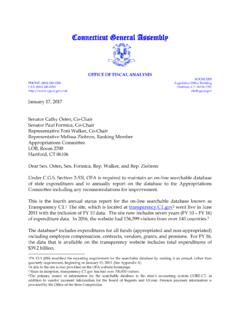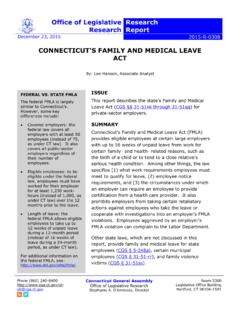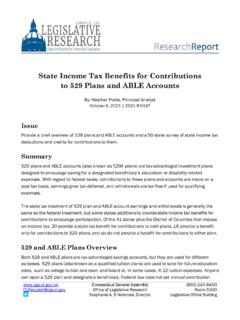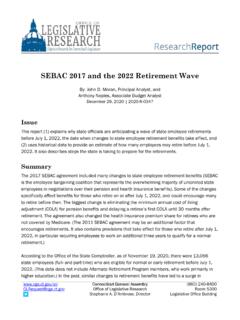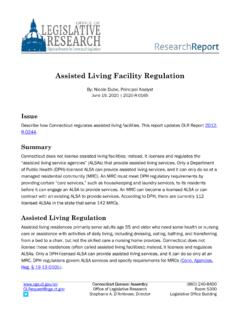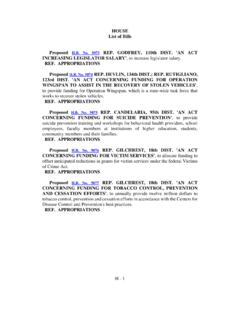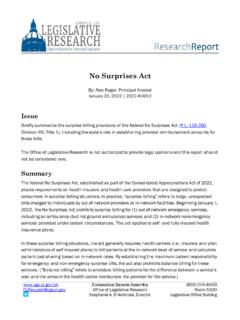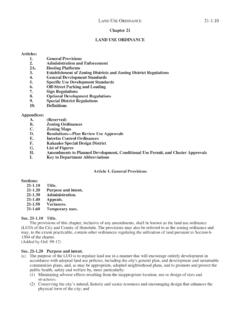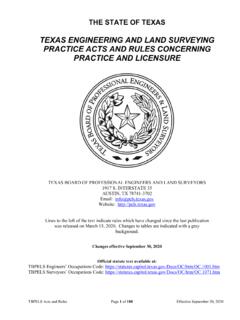Transcription of CGS § 8-30g
1 CGS 8-30g The Affordable Housing land Use Appeals Procedure This Issue Brief has been updated by Issue Brief 2017-R-0158 (August 17, 2017). What is the affordable housing land use appeals procedure and what is its purpose? The procedure requires municipal planning and zoning agencies (hereinafter municipalities ) to defend their decisions to reject affordable housing development applications or approve them with costly conditions. In traditional land use appeals, the developer must convince the court that the municipality acted illegally, arbitrarily, or abused its discretion.
2 The procedure instead places the burden of proof on municipalities. Assisted Housing What types of developments trigger the law's protection? Housing that receives government The proposed development must be an affordable housing development, which assistance to construct or rehabilitate low- and moderate- the law defines to include "set-aside developments and assisted housing. income housing, or housing occupied by individuals receiving Under what circumstances are municipalities subject to the law? rental assistance. With one exception, developers can use the appeals procedure to contest a municipality's decision on an affordable housing development application Set-aside Development submitted to a municipality if (1) fewer than 10% of the municipality's housing A development in which, for at least 40 years after initial units are affordable, based on certain statutory criteria and (2) the municipality occupancy, at least 30% of the has not qualified for a moratorium.
3 Under the exception, a moratorium does not units are deed restricted. apply to appeals related to applications for certain small or low-income assisted Specifically, at least: housing developments. (1) 15% of the units must be deed restricted to households earning 60% or less of the area What types of dwelling units count toward the 10%? median income (AMI) or state Affordable housing is defined to include (1) assisted housing, (2) housing median income (SMI), whichever is less, and currently financed by Connecticut Housing Finance Authority mortgages, (3) (2) 15% of the units must be housing subject to deeds and conditions restricting its sale or rental to low- and deed restricted to households moderate-income people, or (4) mobile homes or accessory apartments subject earning 80% or less of the AMI.
4 To similar deed restrictions. or SMI, whichever is less. August 29, 2017 2017-R-0013. When is a municipality eligible for a moratorium? A municipality is eligible for a four-year HUE Value Unit Type moratorium on appeals taken under the (per unit). Owned or rented market-rate unit in a set-aside development procedure each time it shows it has added Owned or rented elderly unit restricted to households earning affordable housing units, measured in HUE no more than 80% of the median income Owned family unit restricted to 80% of median income (housing unit equivalent) points, equaling the households earning no more than: 60% of median income greater of 2% of the housing stock, as of the last 40% of median income Rented family unit restricted to 80% of median income census, or 75 HUE points.
5 HUE points are households earning no more than: 60% of median income calculated as shown in the adjacent table. 40% of median income How can municipalities defend an appeal brought under the procedure? Municipalities cannot defend an appeal on the grounds that the application does not comply with land use regulations . Instead, to defend an appeal, a municipality must show either: (1) the decision was necessary to protect substantial public interests in health, safety, or other matters the municipal commission may legally consider, and that these interests clearly outweigh the need for affordable housing and cannot be protected by making reasonable changes to the proposed development or (2) the development is (a) receiving no government funds and (b) located in an industrial zone that does not permit residential uses.
6 Why did the legislature enact the law? The state faced an affordable housing crisis in the late 1980s, which the Blue Ribbon Commission on Housing examined. In 1989, the commission submitted its final report to the governor and the legislature. The report included 25 recommendations, one of which concerned an affordable housing appeals procedure. The commission recommended that the state establish a procedure whereby decisions of local land use commissions rejecting an application which would lead to the development of affordable housing [could] (1) be appealed in an expeditious manner, and (2) be judged as to whether the local commission properly considered the need for affordable housing in the community.
7 This recommendation led the legislature to pass 89-311, codified at CGS 8-30g . The law took effect July 1, 1990. How many affordable housing units have been built as a result of the law? It is difficult to determine the number of units added to the state's housing stock under the procedure because no state agency keeps statistics on the number of units built following a successful appeal. Furthermore, developers sometimes use the possibility of an appeal under the procedure as leverage when negotiating a project with a local planning or zoning commission, but there is no way of determining how many units have been approved under such circumstances.
8 CGS 8-30g and the related regulations Municipal Affordable Housing Stock: 2003, 2008, and 2013 (2015-R-0069). Annual Lists Showing Percentage of Affordable Learn Housing in Each Municipality Affordable Housing land Use Appeals Housing Units Built Under the Affordable Housing Appeals Procedure (2013-R- 0143). More Procedure (2013-R-0002). Cases Tried Under the Affordable Housing File 187 (2016), An Act Concerning the Affordable Housing land Use Appeals land Use Appeals Procedure From 2008 to Procedure 2015 (2015-R-0268). Analyst: Julia Singer Bansal Connecticut General Assembly 860-240-8400 |
